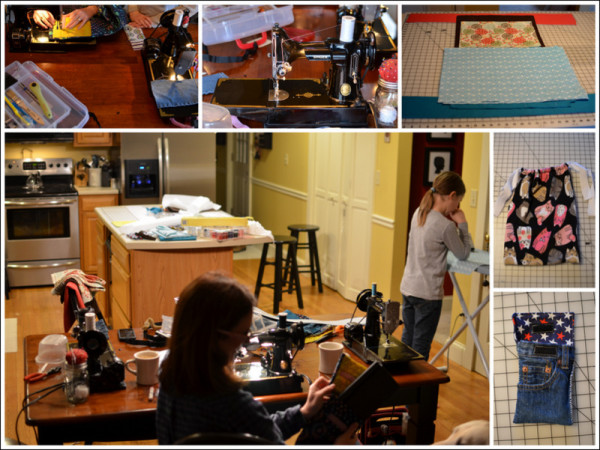The bloggers of iHomeschool Network are getting together to write about some of the common reasons people give for why they couldn’t homeschool…maybe even reasons we had ourselves before we took the leap.

The biggest argument against homeschooling for me (you know, back when I thought only crazy people homeschooled) was “I’d teach all day then plan all night to be ready to teach the next day!” What I meant was: I can’t homeschool because then I wouldn’t have time for anything else!
Here’s what I’ve learned about accomplishing the homeschooling and household duties while still making time for me.
Accomplishing the Homeschooling
My first reality check: I don’t need to be teaching all day. I looked hard at the public school day, a schedule I was familiar with from years of volunteering. I started with their six hour school day and removed the time that the kids were waiting for the next activity or for their classmates to be ready, moving from place to place, having lunch or recess, or in independent reading time.
This is where I’d also like to put in a plug for the efficiency of homeschooling. My daughter picked up math concepts easily, but would still need to listen to more lecture and practice examples for the students who didn’t yet grasp the concept. At home, we can move right on. But I digress.
Working diligently after a prompt start in the morning we can be done our core work (and even some of the extras that don’t happen in public school) before lunch.
As far as planning all night, there are many time saving resources for homeschool teachers.
- There are open-and-go curriculum options. With some everything arrives in one box–you open the teacher’s guide and use it as directed. I won’t give specific recommendations here, because I’m not an expert in any of them. I lean towards curriculum with a bit more teacher involvement, tend to do a fair amount of tweaking, and even put together my own unit studies. Even so, an afternoon once a week is sufficient.
- Some options for home instruction are meant for the child to work through on their own. There are even computer-based programs that do the instructing. We use Teaching Textbooks for math, and this computer-based math curriculum does the lecturing and grading for me.
- Not all instruction must happen separately–a point that is especially important for large families. Other than reading, language arts, and math the rest of our subjects are done together. Many homeschool curricula give options for younger and older children.
Now that I’ve discussed the fact that it really isn’t teaching all day and having to plan all night, I’ll cover some of the other things to do that worried me before taking on this gargantuan task of educating my children.
Accomplishing Household Duties While Homeschooling
With the hours spent homeschooling, how does one accomplish housework, meal preparation, and running errands? This may be the greatest part of homeschooling. Really, I’m not kidding! Don’t think of it as “How will I get all this work done while trying to teach and plan for homeschooling?” Think of it as bringing on extra employees in the household business.
Homeschooling provides wonderful opportunities for life skills training. Public school children rush off to school in the morning, then return to find the house clean, the fridge stocked, and their clean clothes in their drawers. They often aren’t given many chores because they spend their after school time in extracurricular activities or doing homework. Instead of the household fairy doing all the work while they are gone, my children see and help with all the tasks.
- Cleaning: We have short morning chores to tidy the house, longer afternoon chores to clean something, and bigger jobs on the weekend. I put on music and call for a ten-minute tidy when necessary, instead of doing a whole-house pickup after they leave for school or go to bed.
- Cooking: Meal preparation provides practice for many skills. We start with helping to measure and stir, move to preparing easy recipes alone, and add working with heat and sharp tools. It helps the family, is a learning experience, establishes a necessary life skill, and gives them pride as others benefit from their work.
- Errands: Shopping together provides many opportunities to talk about wants and needs and financial management.
Not only does participating in these tasks help get the work of the household done, we are preparing our children for leaving our house and running their own household.
Finding Personal Time When You Homeschool
So how about all the other time a mom needs? I’ve discovered that homeschool isn’t all drudgery, and that you can–and must–make time for other things.
Though being a homeschool mom is a lot of work, I’ve learned that the work is rewarding. In addition to helping my children grow and learn, I am learning along with them! Our history, science, nature, composer, and artist studies engage my brain, too. Not to mention the great books we enjoy together!
Now for things other than homeschooling and housework–and I encourage you not to neglect these areas. It is good for your children to see that you are a person and not just a caretaker. You need time with your spouse, time with other adults, and time alone. You need time to work, pursue personal goals, or just relax. The advice to take care of yourself so you can care for others applies to homeschool moms. You do have to carve out time and make it a priority. There are several ways I structure me-time into my day.
- I take the first hour of the day to myself. Both my children know if they rise early to occupy themselves and let Mommy have her coffee. (Maybe you’re a night owl and staying up late would work better.)
- Don’t forget recess: instead of 15 minutes outside with teachers necessary to watch, I send my kids out and let them play as long as they want.
- A daily habit (and probably my favorite) is Quiet Time, a blessed hour to myself in the middle of the day.
- I also maintain bedtimes. As my children have gotten older we haven’t pushed bedtime later. We simply allow them more time to wind themselves down in bed reading or listening to audio books. Everyone benefits from these periods of quiet time in our day.
Another helpful part of our schedule is a four-day school week. This works because of our year-round schooling and gives me a three-day weekend. Here’s something I’ve noticed, too: because we’ve been working together and engaged all week, my kids are often ready to play together and work on their own personal interests.
Time with your spouse is crucial because your relationship is the foundation of the home. Early bedtimes provides time alone with my husband. We also drive an hour to Grandma’s house and the kids play with her for the afternoon while we go on dates. I encourage you to get creative if you, like us, don’t have the money for babysitters: try family members or swaps with other couples, or at the least at-home dates to give you that time with your spouse.
Time with other adults has actually been easier than I thought. I find that other moms in the same position are looking for adult interaction, too! There are many homeschool events and opportunities even in our small town. Field trips, co-ops, or simple visits are all times to socialize and support each other.
Homeschooling Is Worth It
I am happy to say I was wrong that I wouldn’t have time for anything else if I homeschooled. Not only is my time well spent, but with some creativity I carve out time for myself and my whole family is thriving in this lifestyle.
Be sure to visit iHomeschool Network, where you can be encouraged by experienced homeschoolers. Don’t believe you can’t homeschool because you’re not patient enough or organized enough, or because you don’t have a degree, or you want your kids to play sports, or you still have babies and toddlers. There are numerous myths and we’re all living proof that:
Homeschooling is possible and you can do it!































 Hi, I'm Heidi and I homeschool my two sweet kids. I want them to know that learning is an exciting lifelong adventure! We love great books, unit studies, notebooking, lapbooking, and hands-on learning.
Hi, I'm Heidi and I homeschool my two sweet kids. I want them to know that learning is an exciting lifelong adventure! We love great books, unit studies, notebooking, lapbooking, and hands-on learning.



